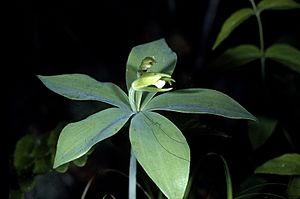Small whorled pogonia facts for kids
Quick facts for kids Small whorled pogonia |
|
|---|---|
 |
|
| Conservation status | |
| Scientific classification | |
| Genus: |
Isotria
|
| Species: |
medeoloides
|
The small whorled pogonia (Isotria medeoloides) is a special kind of orchid. It is also called the little five leaves. You can find this plant growing in forests in eastern North America. It prefers places with a mild climate.
Contents
Where Does It Live?
This rare orchid grows in many places. Its home stretches from southern Maine all the way down to Georgia. It also grows west into southern Ontario, Michigan, and Tennessee. Long ago, it was found in Missouri, but it is not there anymore.
People have always thought this plant was very rare. Some even called it "the rarest orchid east of the Mississippi."
This plant likes to live in forests with hardwood trees or a mix of hardwood and conifer trees. You can often find it in the leaf litter near small, winding streams that sometimes dry up. It lives in the Appalachian Mountains and the Great Lakes region.
What Does It Look Like?
The small whorled pogonia is a plant that grows from a special underground stem called a rhizome. It produces a waxy, gray-green stem that can grow up to about 25 centimeters (10 inches) tall.
Its gray-green leaves are about 8.5 centimeters (3.3 inches) long and 4 centimeters (1.6 inches) wide. They grow in a special circle, or whorl, around the stem.
The flower has green petals that sometimes have yellowish streaks. These petals are usually between 1 and 2 centimeters (0.4 to 0.8 inches) long.
Why Is It Important to Protect It?
This plant is listed as a threatened species by the U.S. Fish and Wildlife Service. This means it is at risk of disappearing if we don't protect it. In 1994, it was changed from "endangered" to "threatened." This happened because more groups of these plants were found, and some were given special protection.
Most states and provinces where it grows still list it as an endangered species. There are about 104 known groups of these plants. However, most of these groups are small, with fewer than 25 plants each.
The biggest danger to the small whorled pogonia is when its home (its habitat) is destroyed. Other things that can harm it include wild pigs, off-road vehicles, and animals like deer and slugs eating the plants. Sometimes, people also collect the plants, which is harmful.
How Is It Related to Other Plants?
This orchid can sometimes be mistaken for another plant called the Indian cucumber (Medeola virginiana). The Indian cucumber also has leaves that grow in a circle and lives in similar places. The name medeoloides actually means "looks like Medeola."
Some old stories say that this orchid only appears every few decades. However, studies in nature do not support these stories. The plant can usually stay dormant (like sleeping) for up to three years before growing again.
See also
 In Spanish: Isotria medeoloides para niños
In Spanish: Isotria medeoloides para niños


